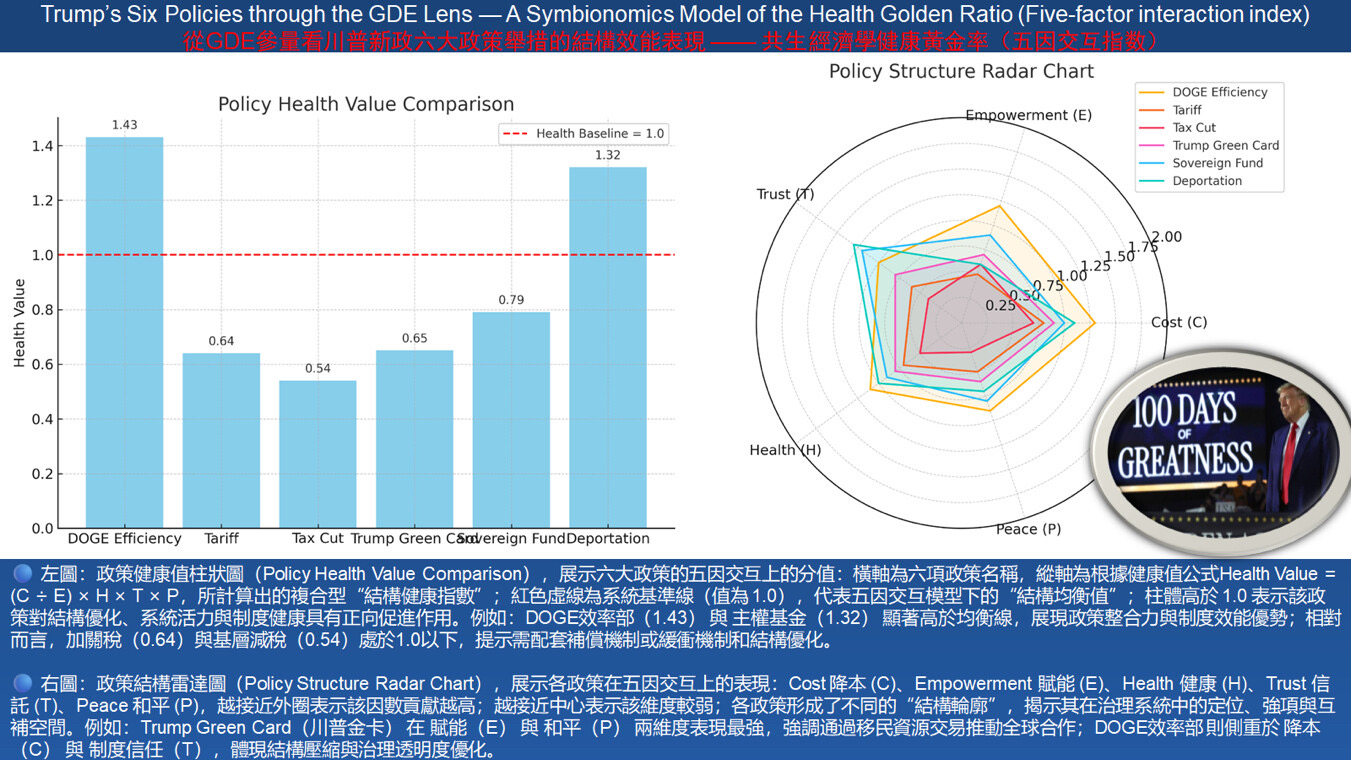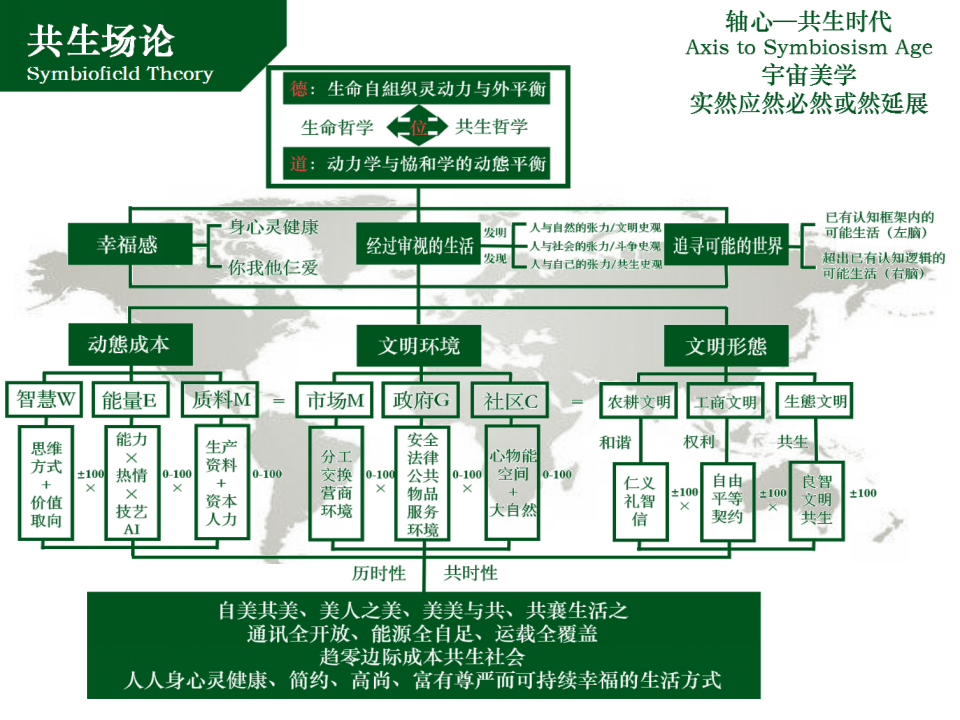New Articles
-
 迈向新世界秩序:以社区生态主权取代地缘政治... 2025/06/23
迈向新世界秩序:以社区生态主权取代地缘政治... 2025/06/23Towards a New World Order: Replacing Geopolitical Sovereignty with Community Ecological Sovereignty迈向新世界秩序...
-
 遣返、消化、改变三大策略并举 2025/06/12
遣返、消化、改变三大策略并举 2025/06/12Deportation, Integration, and Transformation: Three Concurrent Strategies to Address Illegal Immigration 解决“非法移...
-
 川普与马斯克的和解空间 2025/06/08
川普与马斯克的和解空间 2025/06/08川普与马斯克的和解空间 Reconciliation Space Between Trump and Musk ——假如把《大而美法案》改为:Slim and B...
-
 重新定义企业家在文明中的角色 2025/06/03
重新定义企业家在文明中的角色 2025/06/03Redefining the Role of Entrepreneurs in Civilization重新定义企业家在文明中的角色 By Archer Hong Qian &n...
共生思想理论前沿
THE THEORY
-

-

-

-
 关于中文“共生”翻译及对应的人、事、物之说明
关于中文“共生”翻译及对应的人、事、物之说明关于中文“共生”翻译及对应的人、事、物之说明 ——Symbiosism:Charles Thomas Taylor &Qian hong又一次量子缠绕...
查看详细说明
Speech
-
 三大自组织货币的共生格局——宏观世界之数字货币 2021/07/08
三大自组织货币的共生格局——宏观世界之数字货币 2021/07/08三大自组织货币的共生格局 ——宏观世界之数字货币 钱 宏 The Institute for Global Symbiosism(...
-
 新汉字yǜ的释义 2019/11/16
新汉字yǜ的释义 2019/11/16语从金音玉(Yǜ):金口玉言,一诺千金,性人诚恳、执信; &n...
-
 钱宏:中国的真实经验与未来走向(凤凰博报专... 2019/11/16
钱宏:中国的真实经验与未来走向(凤凰博报专... 2019/11/16点击播放 中国的真实经验与未来走向《凤凰博报》专访钱宏主持人:...
川普与马斯克的和解空间
发布时间:2025/06/08 公司新闻 浏览次数:36
川普与马斯克的和解空间
Reconciliation Space Between Trump and Musk
——假如把《大而美法案》改为:Slim and Beautiful Bill Act?
By Archer Hong Qian
川普和马斯克两个大聪明人,围绕《大而美的法案》的不同理解,吵成了一团粥,让全世界都瞠目结舌。其实也没那么复杂。情绪是人的行为动力,但思维方式决定行为方向,不了解这一点,再聪明的人也会犯糊涂,弄不好因不失大把事情搞砸。但是,真正聪明有智慧的人,会很快自我反省,所以,川马一定会和解共生,重归于好!
Trump and Musk, two brilliant minds, have gotten into a heated argument over their differing interpretations of the “Big and Beautiful Bill,” leaving the whole world dumbfounded. Actually, it’s not that complicated. Emotions drive human behavior, but the way of thinking determines the direction of that behavior. Without understanding this, even the smartest people can get confused and, if they’re not careful, mess up a lot of things. However, truly wise and intelligent individuals are quick to self-reflect. So, Trump and Musk will surely reconcile and coexist, returning to good terms!
共生经济学认为,拉菲曲线显示:一个国家的税率与税基往往呈反比率关系,我理解,大美丽法案One Big Beautiful Bill Act,就是“减税率,增税基”法案。只是实行过程中,分寸的把握,也十分重要,必要的批评有利于这个分寸!
这个分寸,就是把握好经济健康黄金率的“五因交互指数”!
这很可能是我尊敬的马斯克先生尖锐批评《大美丽法案》时,存在一个认知盲区,而与个人利益计较没有关系!

川普与马斯克:共生视角下的和解曙光
近日,川普与马斯克两位目标一致的好友因政策分歧引发关注。川普曾表示,若他退出,诉讼和诽谤将消散;马斯克则提到,若他离开DOGE、Tesla、X等,短仓攻击、黑客入侵及死亡威胁或将停止。X帖子显示,两人为美国和人类的未来甘愿冒险,却因分歧让外界担忧。幸好从6月6日起,双方语调开始缓和,展现化解冲突的意愿。
1. 共生经济学与拉弗曲线的核心关系
共生经济学主张经济生态中的政府、企业、个人通过互助协作实现可持续发展,强调资源分配的平衡与各主体的协同增效。拉弗曲线(Laffer Curve)提供了一个量化视角,揭示税率与税基(应税经济总量)呈现反向关系:当税率过高时,过重的税收负担抑制投资、消费和创新,导致税基萎缩;适度降低税率则激励经济活动,扩大税基,最终增加税收收入。这种动态平衡正是共生经济学的实践基础,旨在通过合理的税率政策激发市场活力,同时确保政府有能力支持公共服务,形成良性循环。
2. 《大美丽法案》:减税率增税基的战略意图
《大美丽法案》(One Big Beautiful Bill Act)本质上作为一个惠及80%美国人的“减税率,增税基”法案。假设该法案将公司税从21%降至15%或个人所得税适度下调,其核心目标是通过减轻税负刺激企业投资(如研发、生产)和个人消费,进而扩大经济规模(税基),实现税收收入的长期增长。这与拉弗曲线的最佳点(税率临界值)一致,旨在通过经济活力的提升间接支持财政,而非单纯依赖高税率挤压市场。
3. 分寸的把握:经济健康黄金率的五因交互指数
所谓“分寸的把握”,是指政策实施过程的复杂性。税率过低可能导致财政收入不足,威胁国防(如2025财年1万亿美元预算)或基础设施建设;税率降幅不足则难以有效激发经济,达不到增税基的效果。经济健康黄金率的五因交互指数(降本、赋能、健康、信托、和平)成为衡量这一分寸的工具:
- 降本:降低企业税负,减少运营成本。
- 赋能:通过税收红利支持创新和人力资本。
- 健康:确保公共资源(如医疗)支持劳动力生产力。
- 信托:增强社会对政策的信任,稳定市场预期。
- 和平:为“以实力求和平”提供经济基础。

既然是五因交互,当然就不是孤立单一,而是动态交互:降本和赋能驱动增长质量,健康和信托保障良性稳定,和平确保长期安全。分寸的掌握在于优化这些因素的平衡,达到经济健康、税收收入、投资活力、消费需求和财政可持续性的最佳状态,支撑共生经济学GDE价值趋于交互主体共生的健康黄金律目标。
4. 马斯克批评的认知盲区
马斯克对《大美丽法案》的尖锐批评,出于善意的动机,但很可能源于一个认知盲区,且与个人利益无关,这为分析“川马分歧”提供了一个重要视角。虽然近期X帖子(如@WHLeavitt,2025年6月6日)显示,川普与马斯克因政策分歧已经从6月6日起语调缓和。马斯克可能因技术创新背景,担忧减税导致政府赤字,也影响SpaceX或Tesla的长期项目(如火星移民、电动车普及)。然而,更大的可能是他的批评,忽略以下共生经济学(Symbionomics)的深层逻辑:
- 税基扩大的共生效应:马斯克可能聚焦短期财政风险,未充分认识到减税通过扩大税基如何反哺经济。例如,政府可用增收投资清洁能源或基础设施,间接支持Tesla的可持续发展。
- 五因交互的系统性:他可能强调赋能和降本的直接效益,未全面评估健康、信托、和平如何通过政策分寸增强经济韧性,间接助力其愿景。
- 非个人利益驱动:马斯克的批评或源自对宏观经济稳定性的关切,而非个人得失,反映了他对政府效率的期待(例如避免赤字浪费)。
这一盲区可能源于思维方式差异:马斯克注重技术跃迁,川普关注结构平衡。GDE(国内总效能)体系的五因交互视角,或能弥合这一认知鸿沟,将两者的目标纳入共生场。

5. 综合洞察
共生经济学通过拉弗曲线揭示税率与税基的反向关系,《大美丽法案》作为减税率增税基的实践,需精准把握分寸。经济健康黄金率的五因交互指数提供了一个动态框架,平衡降本、赋能、健康、信托、和平,优化经济生态。马斯克的批评虽出于对宏观经济的担忧,却可能未见减税的共生效应和五因交互的系统价值,这与其个人利益无关,而是认知层面的盲点。当前(2025年6月7日23:11 +01),川普与马斯克的缓和迹象,或许是向共生视角转变的契机。
减税需以共生经济学为指导,依赖拉弗曲线的科学依据,并通过五因交互把握分寸。川普总统应该理解,马斯克的认知盲区并非自私,而是对系统性共生效应的忽视,这为川普与马斯克的和解提供了思考空间。
“In fact, since Trump’s ‘One Big Beautiful Bill Act’ (abbreviated as OBBBA or OBBB) is a tax cut bill, why not change one word and call it the ‘Slim and Beautiful Bill Act’?
This might not only give a nod to our friend Musk but also be more factual and align with the ‘Golden Rule of Economic Health’!
In short, whether it’s brothers or father and son, don’t fight or be ruthless—let the bill pass in the Senate smoothly!”
其实,川普的《大而美的法案》,既然是减税法案,那么,不妨改一个字,叫《瘦而美的法案》也许既给了朋友马斯克一个面子,也更实事求是,而且,还符合“经济健康黄金率”!
总之,兄弟也好,父子也吧,不要打架斗狠,让法案在参议院获得通过才好!

Reconciliation Space Between Trump and Musk
By Archer Hong Qian
A Thought: Renaming the “One Big Beautiful Bill Act” to the “Slim and Beautiful Bill Act”?
Trump and Musk, two brilliant minds, have gotten into a heated argument over their differing interpretations of the “Big and Beautiful Bill,” leaving the whole world dumbfounded. Actually, it’s not that complicated. Emotions drive human behavior, but the way of thinking determines the direction of that behavior. Without understanding this, even the smartest people can get confused and, if they’re not careful, mess up a lot of things. However, truly wise and intelligent individuals are quick to self-reflect. So, Trump and Musk will surely reconcile and coexist, returning to good terms!
Since Trump’s “One Big Beautiful Bill Act” (abbreviated as OBBBA or OBBB) is fundamentally a tax-cut bill, why not tweak one word and call it the “Slim and Beautiful Bill Act”? This could not only pay tribute to our friend Musk but also reflect the bill’s factual intent and align with the “Golden Rule of Economic Health.” Ultimately, whether they are like brothers or father and son, avoiding conflict and ensuring the bill passes smoothly in the Senate would be ideal!
In fact, Trump’s “One Big Beautiful Bill Act,” being a tax-cut initiative, might benefit from this rename—offering Musk a nod, staying true to its purpose, and harmonizing with economic health principles. Let’s hope for unity and a seamless legislative journey!
The Dawn of Reconciliation Under a Symbiotic Perspective
Recently, the policy disagreements between Trump and Musk, two like-minded friends united by common goals, have drawn attention. Trump has suggested that quitting would dissolve lawsuits and defamation issues, while Musk noted that leaving DOGE, Tesla, X, and related ventures might halt short-selling attacks, hacks, and death threats. X posts (e.g., @WHLeavitt, June 6, 2025) highlight their willingness to risk their lives for America and humanity, yet their rift has sparked public concern. Fortunately, since June 6, both have softened their tones, signaling a willingness to resolve the conflict.
1. The Core Relationship Between Symbiotic Economics and the Laffer Curve
Symbiotic economics advocates for a sustainable economic ecosystem where government, businesses, and individuals collaborate, emphasizing balanced resource allocation and synergistic growth. The Laffer Curve provides a quantitative lens, showing an inverse relationship between tax rates and the tax base (the taxable economic total): excessively high tax rates suppress investment, consumption, and innovation, shrinking the tax base, while moderate reductions stimulate economic activity, expand the tax base, and increase revenue. This dynamic balance underpins symbiotic economics, aiming to boost market vitality through rational tax policies while ensuring government capacity for public services, fostering a virtuous cycle.
2. The Strategic Intent of the “One Big Beautiful Bill Act”
The “One Big Beautiful Bill Act,” understood as a “tax-cut-to-increase-tax-base” bill benefiting 80% of Americans, seeks to lower tax rates (e.g., corporate tax from 21% to 15% or adjusted personal income tax) to stimulate corporate investment (e.g., R&D, production) and personal consumption, thereby expanding the economic scale (tax base) and securing long-term revenue growth. This aligns with the optimal point on the Laffer Curve, prioritizing economic vitality over reliance on high tax rates to squeeze the market.
3. The Art of Balance: The Five-Factor Interaction Index of the Economic Health Golden Rate
The “art of balance” in policy implementation is critical. Excessively low tax rates may lead to insufficient fiscal revenue, jeopardizing defense (e.g., the 2025 fiscal year $1 trillion budget) or infrastructure; inadequate tax cuts may fail to effectively expand the tax base. The five-factor interaction index of the Economic Health Golden Rate (cost reduction, empowerment, health, trust, peace) serves as a tool to gauge this balance:
- Cost Reduction: Lowers corporate tax burdens, cutting operational costs.
- Empowerment: Leverages tax relief to foster innovation and human capital.
- Health: Ensures public resources (e.g., healthcare) support workforce productivity.
- Trust: Strengthens societal confidence in policy, stabilizing market expectations.
- Peace: Provides an economic foundation for “peace through strength.”
These factors are not isolated but interact dynamically: cost reduction and empowerment drive growth, health and trust ensure stability, and peace guarantees long-term security. Mastering this balance optimizes growth, tax revenue, investment vitality, consumption demand, and fiscal sustainability, aligning with the ecological goals of symbiotic economics.
4. Musk’s Cognitive Blind Spot in Criticism
Musk’s sharp criticism of the “One Big Beautiful Bill Act,” likely driven by good intentions, may stem from a cognitive blind spot unrelated to personal gain, offering a key perspective on the “Trump-Musk divide.” Despite recent X posts (e.g., @WHLeavitt, June 6, 2025) showing a softening of tones since that date, Musk, with his technology innovation background, might worry that tax cuts could lead to government deficits, impacting long-term projects like SpaceX’s Mars colonization or Tesla’s electric vehicle expansion. However, his critique may overlook deeper symbiotic economics (Symbionomics) insights:
- Symbiotic Effect of an Expanded Tax Base: Musk might focus on short-term fiscal risks, missing how tax cuts could expand the tax base, enabling government investments in clean energy or infrastructure to indirectly support Tesla’s sustainability.
- Systemic Nature of the Five-Factor Interaction: He may emphasize the direct benefits of empowerment and cost reduction, underestimating how health, trust, and peace, through balanced policy, enhance economic resilience and support his vision.
- Non-Personal Interest Motivation: His criticism likely reflects concern for macroeconomic stability and government efficiency (e.g., avoiding deficit waste), rather than personal gain.
This blind spot may arise from differing mindsets: Musk prioritizes technological leaps, while Trump focuses on structural balance. The GDE (Gross Domestic Efficacy) system’s five-factor interaction perspective could bridge this gap, integrating their goals into a symbiotic field.
5. Comprehensive Insights
Symbiotic economics, via the Laffer Curve, highlights the inverse relationship between tax rates and the tax base. The “One Big Beautiful Bill Act,” as a tax-cut-to-increase-tax-base initiative, requires precise balance. The five-factor interaction index of the Economic Health Golden Rate provides a dynamic framework, harmonizing cost reduction, empowerment, health, trust, and peace to optimize the economic ecosystem. Musk’s criticism, though rooted in macroeconomic concerns, may miss the symbiotic effects and systemic value of the five-factor interaction, a blind spot unrelated to personal interest. As of 11:37 PM +01 on June 7, 2025, the softening tones between Trump and Musk signal a potential shift toward a symbiotic perspective.
Tax cuts should be guided by symbiotic economics, grounded in the Laffer Curve’s science, and balanced through the five-factor interaction. President Trump should recognize that Musk’s blind spot stems not from selfishness but from overlooking systemic symbiotic effects, opening a space for reconciliation.
Transforming the Post-WWII GDP Paradigm: Only the Five-Factor Interaction Index of the GDE System Can Reveal and Resolve the Essence of the “Trump vs. Musk” Tension!
The five-factor interaction index based on GDE (Gross Domestic Efficacy) offers a new lens to evaluate civilization—one that shifts from expansion-driven to efficacy-driven values. These five factors are:
• C1: Cost Reduction (C)
• C2: Empowerment (E)
• C3: Health (H)
• C4: Trust (T)
• C5: Peace (P)
Together, they form a composite index that evaluates the Health Value of a political-economic system, as expressed by the following formula:

\text{Health Value} = \left( \frac{C}{E} \times H \times T \times P \right)^{1/3} \times 10
This restructured evaluative model allows us to go beyond the outdated GDP growth metrics and understand the structural balance advocated by Trump alongside the technological transcendence pursued by Musk as part of a higher-dimensional interactive symbiotic field, rather than viewing them as inherently contradictory.
The Puerta de Alcalá, as captured in the image, serves as a powerful symbol—once a gateway from imperial Madrid to the outer world, it now stands as a metaphorical threshold between old regimes (GDP-ism) and a new civilization based on GDE symbiotic values.
請翻译
改变二战以来GDP评价标准,用GDE价值体系的五因(降本、赋能、健康、信托、和平)交互指数,才能看清并缓解“川普马斯克之争”的本质!
以GDE(Gross Domestic Efficacy)为基础的五因交互指数——
• C1 降本(Cost reduction)
• C2 赋能(Empowerment)
• C3 健康(Health)
• C4 信托(Trust)
• C5 和平(Peace)
能重构一个“效能导向而非扩张导向”的文明评价体系,从而将川普强调的社会内生结构平衡,与马斯克追求的技术跃迁未来愿景,纳入一个更高维度的交互共生场中,值重构而非相互抵牾。
上一篇: 遣返、消化、改变三大策略并举
下一篇: 重新定义企业家在文明中的角色













您好!请登录
已有0评论
购物盒子